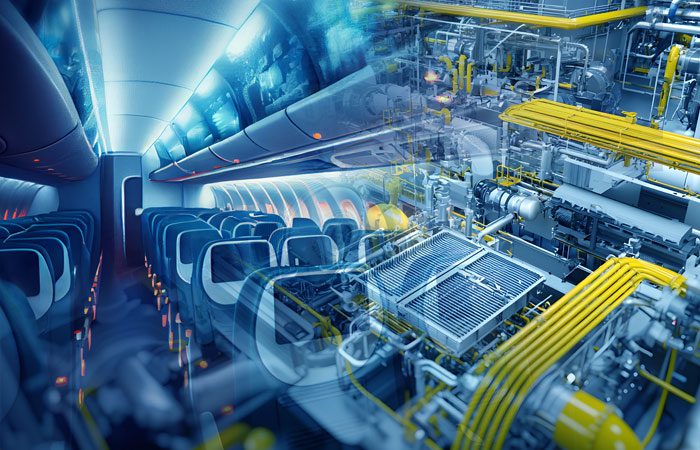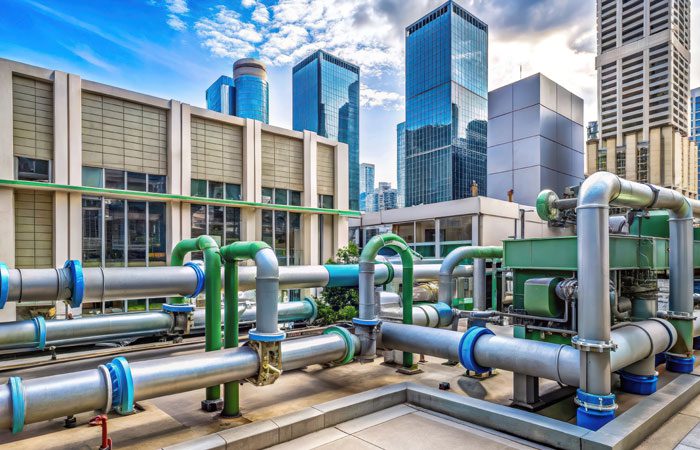
Reimagining Cabin Comfort: Optimizing Aircraft HVAC Systems for Modern Layouts
In modern aviation, the passenger cabin is constantly evolving. Airlines are densifying layouts, introducing new service classes, and integrating smarter monuments. VIP and business jet operators are turning cabins into living spaces with bedrooms, lounges, and showers. Each change brings aesthetic and commercial benefits—but also a complex technical challenge: maintaining consistent cabin comfort and efficiency.
The Heating, Ventilation, and Air Conditioning (HVAC) system sits at the heart of this challenge. It governs airflow, temperature, humidity, and noise levels—variables that together define the passenger experience. Yet when layouts shift, these systems are among the most affected.
For TAAL Tech, HVAC optimization isn’t a peripheral service. It’s a core discipline that combines mechanical design, systems integration, and digital validation. Our engineers work across OEM, Tier-1, and VIP programs, helping customers design cabins that stay comfortable, compliant, and energy-efficient—no matter how complex the configuration becomes.
Changing Layouts, Changing Airflows
Every interior modification triggers a chain reaction through the HVAC system. A relocated galley alters the mid-cabin flow path. A new monument or storage bulkhead changes heat distribution. Densified seating increases localized CO₂ and heat loads. Even a minor repositioning of diffusers can shift cabin acoustics.
In legacy programs, HVAC adjustments often came late in the design cycle, leading to reactive fixes and prolonged testing. Today, design and verification start early—within digital mock-ups that integrate airflow modeling and temperature mapping from the concept stage. Engineers can now predict with high accuracy how a reconfigured cabin will behave thermally, long before ducts are manufactured.
This proactive approach shortens development cycles, minimizes rework, and ensures passenger comfort remains consistent even when interior geometry changes dramatically.
From Simulation to Certifiable Reality
Modern HVAC design depends heavily on virtual validation. At TAAL Tech, engineering teams use computational fluid dynamics (CFD), 3D modeling, and system-level simulations to replicate cabin environments under various flight and occupancy conditions.
Digital airflow models help answer questions such as:
- How will air distribute across a denser business-class section?
- Will the new diffuser locations maintain uniform temperature?
- How will monument geometry affect condensation and acoustic profiles?
These simulations are then correlated with environmental test data to ensure real-world fidelity. Once validated, the models guide duct routing, diffuser selection, and pack flow calibration. This “model-to-certify” workflow enables faster approvals and more predictable performance across cabin variants.
The result is a significant reduction in physical prototyping cycles—a critical advantage in today’s compressed certification timelines.
Engineering Priorities in HVAC Optimization
Optimizing HVAC for modern layouts is not just about moving air; it’s about managing interactions between structure, systems, and human comfort. Several technical priorities guide this process:
Cabin zoning and load distribution
Each cabin zone—from cockpit to aft galley—has distinct thermal behavior. High-power IFEC systems, lighting, and passenger density contribute varying heat loads. Engineers must analyze how these loads shift across new layouts and recalibrate zone controllers accordingly to maintain balance.
Duct routing and pressure drop
Modified interiors often demand rerouted ducts. Maintaining optimal pressure and minimal turbulence requires precise CFD-based redesigns. This ensures efficient airflow and reduced cabin noise, even with compact or curved geometries.
Integration with electrical and avionics systems
As aircraft integrate more electrical equipment, localized heat sources multiply. HVAC systems must coordinate with avionics cooling and environmental control packs to avoid hot spots and ensure electrical reliability.
Air quality and filtration
Post-pandemic norms have tightened air-exchange and filtration requirements. Updated cabin designs must maintain easy filter access while ensuring uniform air refresh rates throughout all sections.
Weight and energy optimization
Every duct, valve, or sensor adds mass. Engineers must find the balance between comfort and efficiency—using lightweight materials and optimizing pack flow rates to reduce overall fuel burn.
The Digital Advantage: Continuous Feedback Loops
Today’s aircraft generate a constant stream of environmental data. Temperature, humidity, and airflow readings from onboard sensors can feed digital twins that mirror HVAC performance in real time.
By analyzing these digital twins, TAAL Tech’s engineers can detect anomalies—like uneven airflow or fan load fluctuations—well before they cause passenger discomfort or maintenance issues. Predictive models built from operational data enable proactive servicing and continuous optimization across the fleet.
This fusion of design and data is transforming HVAC systems from passive utilities into intelligent, adaptive subsystems that evolve over time.
Sustainability and the Future of Environmental Control
Sustainability pressures are reshaping HVAC system design. Efficient air management directly reduces bleed-air extraction and power draw, lowering fuel consumption. Lightweight duct materials, optimized routing, and smart controls contribute measurable gains in environmental performance.
In electric and hybrid-electric aircraft, these benefits multiply. The HVAC and ECS systems influence thermal management of batteries and electrical components—making efficiency a design-critical factor rather than an afterthought.
TAAL Tech is actively developing digital and AI-assisted control strategies that allow HVAC systems to adjust dynamically based on occupancy, altitude, and external temperature—improving both energy efficiency and passenger experience.
The TAAL Tech Approach: Engineering the Environment, Not Just the Airflow
Optimizing HVAC performance is not just a matter of redirecting ducts or resizing diffusers—it’s about understanding how air, heat, and systems interact across the entire cabin ecosystem. At TAAL Tech, we treat HVAC engineering as a cornerstone of aircraft interior design and environmental systems integration.
Our experience spans new-build and retrofit programs where layout modifications demanded complete revalidation of the environmental control system. Through these projects, we’ve built a methodology that combines digital precision with certifiable outcomes.
- Integrated thermal-flow modeling links CFD analysis with cabin geometry to predict temperature gradients and air velocities early in the design phase.
- System-level impact assessments ensure HVAC changes align with bleed-air management, avionics cooling, and electrical load requirements.
- Smart retrofit methodologies help customers upgrade existing layouts without excessive weight addition or loss of performance.
- Certification-ready documentation aligns analyses and test data with DO-160 and FAR 25.831 requirements, reducing certification risk.
- Data continuity through digital twins provides operators with real-time performance insights and predictive maintenance capabilities.
This integrated approach allows TAAL Tech to act as a true engineering partner—bridging concept design, digital validation, and lifecycle optimization for every stage of the program.
Turning Comfort into Competitive Advantage
Cabin comfort is no longer a soft metric—it’s a differentiator that drives passenger loyalty, brand value, and operational efficiency. The HVAC system, though largely invisible, is fundamental to achieving it.
For aerospace companies adapting to new layouts, modernizing interiors, or introducing sustainable aircraft platforms, HVAC optimization offers measurable impact: reduced energy consumption, improved thermal balance, and enhanced passenger experience.
By combining digital simulation, cross-disciplinary engineering, and real-world validation, TAAL Tech helps customers engineer not just airflow—but the environment itself. In doing so, we’re helping define what comfort and efficiency mean in the next generation of flight.


